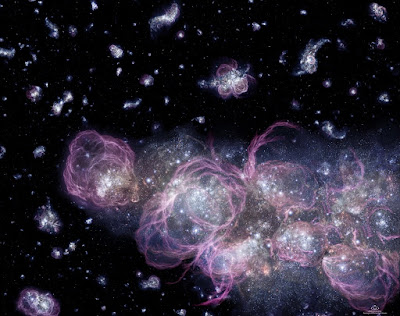 |
| Image courtesy : NASA |
• The James Webb Space Telescope (JWST) is the world's most advanced space observatory, dedicated to unraveling the secrets of the cosmos. Since its deployment, JWST has transformed our view of the universe, revealing previously unknown data about galaxies, exoplanets, and celestial events. Let's look at some of the telescope's most amazing finds.
A New Window into the Early Universe.
 |
| Image courtesy : NASA |
• One of JWST's key tasks is to investigate the early universe. Its strong infrared instruments discovered galaxies that formed just a few hundred million years after the Big Bang. JWST discovered some of the most ancient and distant galaxies, providing insight into the universe's origins. These findings help scientists comprehend how galaxies developed over billions of years.
Supermassive Black Holes: JWST unexpectedly detected supermassive black holes in the early universe. These observations call into question prevailing theories regarding how such enormous objects formed so fast after the Big Bang.
Exploring Exoplanets:
 |
| Image courtesy: NASA |
• Searching for Life Beyond Earth JWST has made groundbreaking contributions to the study of exoplanets, giving light on their atmospheres and composition.
Water Vapor Detection: JWST found water vapor in the atmosphere of a gas giant exoplanet. This discovery demonstrates the telescope's unrivaled ability to examine planetary atmospheres.
Signs of Habitability: The telescope discovered methane and carbon dioxide on K2-18 b, an exoplanet in the habitable zone of its star. These findings open up interesting possibilities for future exploration of potentially habitable planets.
Exploring Stellar and Galactic Phenomena
 |
| Image Courtesy: NASA |
• The telescope has made extensive observations of star formation and galaxy evolution, revealing new information about the dynamics of the universe.
'Red Monster' Galaxies: JWST discovered ultra-massive galaxies that lived more than 12.8 billion years ago. These "monsters" demonstrate how quickly galaxies expanded in the early universe.
'Firefly Sparkle' Galaxy: The finding of this newborn galaxy aids scientists in understanding the early phases of the Milky Way's evolution.
JWST's Impact on Space Science
 |
| Image Courtesy : NASA |
• JWST's discoveries are transforming our understanding of the universe. Its ability to see further into space than any previous telescope is providing solutions to some of astronomy's most pressing concerns. From studying the origins of galaxies to finding the building components of life on distant worlds, JWST is laying the groundwork for future exploration.
Discovering Hidden Forces in the Universe.
 |
| Image Courtesy: NASA |
• JWST is aiding our understanding of two major mysteries in the universe: dark matter and dark energy. Dark matter is invisible to us, yet it has an impact on the shape of galaxies. JWST demonstrates how this invisible substance alters the way light passes across space.
Dark energy is the driving force behind the universe's expansion and acceleration. JWST is helping us understand why this occurs by analyzing distant galaxies. These discoveries could help us better grasp how the cosmos works and what it is comprised of.
Unlocking the Secrets of Black Holes
 |
| Image Courtesy: NASA |
• JWST is also assisting scientists in studying black holes, which are among the most mysterious things in space. JWST's strong cameras allow it to observe black holes in galaxies, including ones that are millions or billions of times the size of the sun.
• The telescope may investigate how supermassive black holes influence their surroundings, such as how they attract gas and shape entire galaxies. These findings may help scientists learn more about how black holes form and how they affect the formation of stars and galaxies surrounding them.




.jpeg)

0 Comments